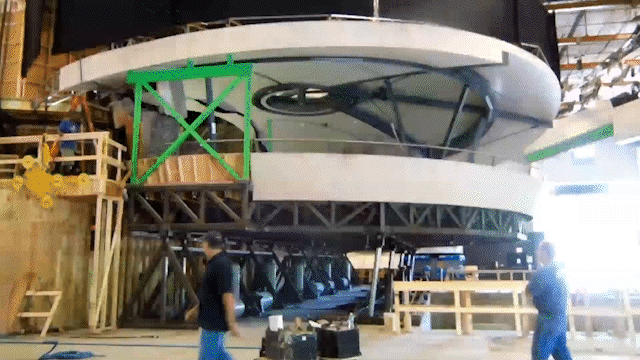How To Throw Iron man's House off a Cliff
This is an excerpt from a lecture I give on maintaining design consistency on a project with multiple concurrent pipelines. In essence, it’s a lecture on using digital technologies for cross department communication. However, it is also a lecture on how to throw a large house over cliff, reset and do it again.
All images created by me unless noted otherwise.
The Finished Set for Iron Man’s Living Room. If you look very closely, you can me in the back standing by the stair. (Photo by Jay Pelissier)
On Iron Man 3 I had the honor of working on Iron Man’s house. We had the iconic design from the first two films but we also had an opportunity: in the timeline of the movies, the house had been seriously damaged at the end of Iron Man 2. It was the perfect opportunity to give the house a little rehab. I love the mid-century design of the original, but for our story, we wanted to give it a bit of an update.; bring it into the 21st century without the essential character that made it cool.
We removed the boulders, replaced the water feature, gave the finishes a modern upgrade and made the whole space bigger. But here’s the thing (spoilers ahead).
Still from Iron Man 3
We were going to have to destroy it again. And this time we had to do more than just poke a few holes in the ceiling: We had to throw the whole damn thing off Point Dume. And then we had to reset and to do it again for take 2.
Riding the set during one of our initial tests.
We built a 4400 sq ft set, 1200 sq ft of which hinged down at a 22.5 deg angle. It could be raised and lowered as needed for camera and then reset to do it all again. This set would then be extended by VFX and worked into the entirely digital exterior shots of the house.
In order to deliver this sequence for the final movie we would have to coordinate across multiple departments and make sure each one was working off the same info we had and towards the same purpose. Otherwise, you could end with spatial logistics that don’t make any sense in the final movie, action that doesn’t tell the story and a lot of overtime to try and fix it so you don’t get an audience that leaves unsatisfied. We accomplished all this by having a really solid digital model that came from the art dept and that we could use to communicate to all the other departments.
From that model, we could generate renders for concept art, animatics to explain our plan, construction drawings and CNC files for the set build and then we could hand it off to SPFX for engineering and VFX so they could plan for and execute their set extensions. Starting with a solid and precise 3d model allowed us to communicate to all the other departments and maintain multiple simultaneous pipelines.
So that when everything was composited and cut together in the final movie, it would all come together to deliver the impact we wanted to our audience.
Some of my favorite sets to design are the one’s that operate as more than a backdrop but take place as key parts of the narrative action. They don’t have to blow up, slide down a cliff or flood to be interesting, but a set really comes to life when it provides opportunities for actors to do more than stand and deliver lines. When you have a set that that is more than a backdrop, it really comes alive and becomes an essential part of the story.





















